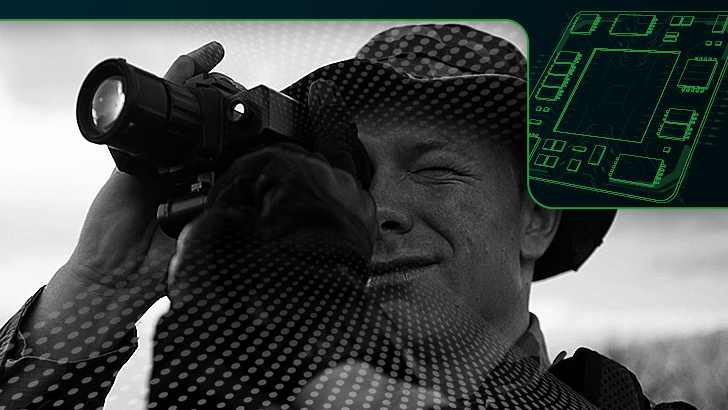

Objective
The innovative approach of this topic is its focus on reducing the size, weight and power of the technology in addition to performance requirements.
Description
Missions require multiple sensors to achieve specific objectives. Present sensors use extended-range imaging applications that rely on antiquated technology. This results in extreme sensitivity to size, weight and power. These dismounted sensor configurations either necessitate separate imaging devices, or complex filtering schemes that increase system SWaP, to maintain operational effectiveness in all environments.
Nevertheless, imaging sensors allow for more advanced target discrimination against advanced threats in multiple bands, complex scenes and various atmospheric conditions. If multiple sensor bands can offer simultaneous imaging on the same detector, technologies gain lower SWaP and less sensitive subcomponent alignments, resulting in less complicated systems.
Phase I
Phase I will cover an anticipated 3-month period to complete a System Design Review. During this time, proposed solutions will undergo a systems-trade analysis, which will look at performance optimization compared with the expected SWaP and Phase II goals. The final design will have illustrated conceptual drawings and performance predictions at the detector level to support system-level feasibility studies by the Government. Businesses will receive additional details and specifications upon award.
Phase II
Phase II will cover an expected 20-month period to further develop and finalize dual-band detectors specifically tailored for the dismounted Soldier on stacked structures for simultaneous imaging capabilities in the Short-Wave and Mid-Wave Infrared. This project will study varying detector design parameters to minimize crosstalk while improving the detector Modulation Transfer Function (MTF) when paired with optimized optical configurations. The project will also require prototypes for test and integration.
Businesses will tailor their integrated Dewar Cooler Assembly for light weight, minimal power-consuming dismounted applications. The IDECA FPA shall have a minimum format of 1280 x 720 with a minimal detector pixel pitch. The project will receive validation through two approaches: one with the Government Furnished Equipment optics for demonstration of final imaging, then retrofitted into an existing host prototype. Business technologies will receive additional details and specifications upon award.
Phase III
Phase III will include the complete maturation of the company’s technology developed in Phase II. The business will produce prototypes to support further development and commercialization.
Submission Information
For more information, and to submit your full proposal package, visit the DSIP Portal.
Objective
The innovative approach of this topic is its focus on reducing the size, weight and power of the technology in addition to performance requirements.
Description
Missions require multiple sensors to achieve specific objectives. Present sensors use extended-range imaging applications that rely on antiquated technology. This results in extreme sensitivity to size, weight and power. These dismounted sensor configurations either necessitate separate imaging devices, or complex filtering schemes that increase system SWaP, to maintain operational effectiveness in all environments.
Nevertheless, imaging sensors allow for more advanced target discrimination against advanced threats in multiple bands, complex scenes and various atmospheric conditions. If multiple sensor bands can offer simultaneous imaging on the same detector, technologies gain lower SWaP and less sensitive subcomponent alignments, resulting in less complicated systems.
Phase I
Phase I will cover an anticipated 3-month period to complete a System Design Review. During this time, proposed solutions will undergo a systems-trade analysis, which will look at performance optimization compared with the expected SWaP and Phase II goals. The final design will have illustrated conceptual drawings and performance predictions at the detector level to support system-level feasibility studies by the Government. Businesses will receive additional details and specifications upon award.
Phase II
Phase II will cover an expected 20-month period to further develop and finalize dual-band detectors specifically tailored for the dismounted Soldier on stacked structures for simultaneous imaging capabilities in the Short-Wave and Mid-Wave Infrared. This project will study varying detector design parameters to minimize crosstalk while improving the detector Modulation Transfer Function (MTF) when paired with optimized optical configurations. The project will also require prototypes for test and integration.
Businesses will tailor their integrated Dewar Cooler Assembly for light weight, minimal power-consuming dismounted applications. The IDECA FPA shall have a minimum format of 1280 x 720 with a minimal detector pixel pitch. The project will receive validation through two approaches: one with the Government Furnished Equipment optics for demonstration of final imaging, then retrofitted into an existing host prototype. Business technologies will receive additional details and specifications upon award.
Phase III
Phase III will include the complete maturation of the company’s technology developed in Phase II. The business will produce prototypes to support further development and commercialization.
Submission Information
For more information, and to submit your full proposal package, visit the DSIP Portal.
